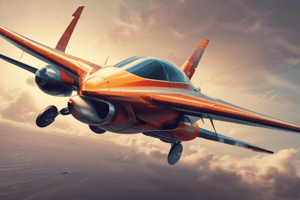Podcast
Questions and Answers
What is the purpose of lift force on an aircraft?
What is the purpose of lift force on an aircraft?
- To resist the forward motion
- To maintain altitude and stability (correct)
- To generate thrust
- To increase drag
Which force is proportional to the square of the speed of an object moving through a fluid?
Which force is proportional to the square of the speed of an object moving through a fluid?
- Lift force
- Weight force
- Drag force (correct)
- Thrust force
What part of an aircraft generates lift force?
What part of an aircraft generates lift force?
- Engines
- Tail
- Fuselage
- Wings (correct)
What is the resistance experienced by an object moving through a fluid called?
What is the resistance experienced by an object moving through a fluid called?
Which concept involves investigating the effects of gas dynamics on both flying objects and motionless objects?
Which concept involves investigating the effects of gas dynamics on both flying objects and motionless objects?
What role does the airfoil design play in aircraft performance?
What role does the airfoil design play in aircraft performance?
Which of the following is a common drag reduction technique used in aerodynamics?
Which of the following is a common drag reduction technique used in aerodynamics?
What is the main function of boundary layers in aerodynamics?
What is the main function of boundary layers in aerodynamics?
Why do aircraft have smooth, curved surfaces?
Why do aircraft have smooth, curved surfaces?
Which type of boundary layer exhibits properties of both laminar and turbulent flows?
Which type of boundary layer exhibits properties of both laminar and turbulent flows?
Study Notes
Aerodynamics: Understanding Lift and Drag Forces, Airfoil Design, Drag Reduction Techniques, and Boundary Layers
Aerodynamics is the study of the interactions between moving air (or other gases) and bodies within that flow. It involves investigating the effects of these gas dynamics on both flying objects, such as aircraft, and motionless objects, like buildings. In this article, we'll explore several key concepts related to aerodynamics, including lift and drag forces, airfoil design, drag reduction techniques, and boundary layers.
Lift and Drag Forces
Lift and drag forces are two fundamental components of fluid mechanics, specifically in relation to aerodynamics. They play critical roles in understanding how objects interact with their surrounding environments.
Lift Force
Lift force, also known as lift reaction or lift drag, is the force that opposes the forward motion of an aircraft. It is perpendicular to the direction of motion and is crucial for maintaining altitude and maintaining stability in the vertical direction. Lift is generated by the shape of the wings, known as the airfoil, which we will discuss in the upcoming section.
Drag Force
Drag force, also known as parasitic drag, is the resistance experienced by an object moving through a fluid. It is in the direction of the object's motion and is proportional to the square of the speed of the object. Drag force is critical in determining the performance of aircraft, and reducing it is a key focus in aerodynamics.
Airfoil Design
An airfoil is the curved shape of the cross-section of an aircraft wing, or any other body designed for flight. The airfoil design plays a crucial role in generating lift force.
Wing Sections
There are various types of wing sections used in aircraft design, each with its own advantages and disadvantages. Some common wing sections include the NACA 0012, NACA 23012, and NACA 4412. The specific wing section used depends on the desired performance characteristics of the aircraft.
Drag Reduction Techniques
Drag reduction is a critical aspect of aerodynamic design, as it directly affects the performance and fuel efficiency of aircraft. Several techniques are used to minimize drag:
Streamlined Shapes
Ensuring that the body of an aircraft is streamlined, or having a smooth, continuous shape with minimum surface area, can significantly reduce drag. This is why aircraft have smooth, curved surfaces and why turbulence is minimized.
Vortex Generators
Vortex generators are small devices attached to the surface of an aircraft's wings to create vortices, which help to separate the boundary layer from the wing's surface more evenly. This results in a more efficient flow of air over the wing, reducing drag.
Boundary Layers
A boundary layer is a region near a solid surface where the fluid velocity is significantly reduced due to viscous forces. This layer plays a crucial role in determining the overall aerodynamic performance of an object.
There are three main types of boundary layers: laminar, turbulent, and transitional. Transitional boundary layers exhibit properties of both laminar and turbulent flows. Each type has its own unique characteristics and behavior patterns.
Understanding aerodynamics requires a deep understanding of various factors, from the basic principles of lift and drag forces to more complex concepts like airfoil design, drag reduction techniques, and boundary layers. By studying these aspects, engineers can create more efficient and effective aircraft designs, leading to improved flight performance and reduced fuel consumption.
Studying That Suits You
Use AI to generate personalized quizzes and flashcards to suit your learning preferences.
Description
Test your knowledge of aerodynamics by exploring concepts like lift and drag forces, airfoil design, drag reduction techniques, and boundary layers. Dive into the fundamental principles that govern the interactions between moving air and objects within that flow.




